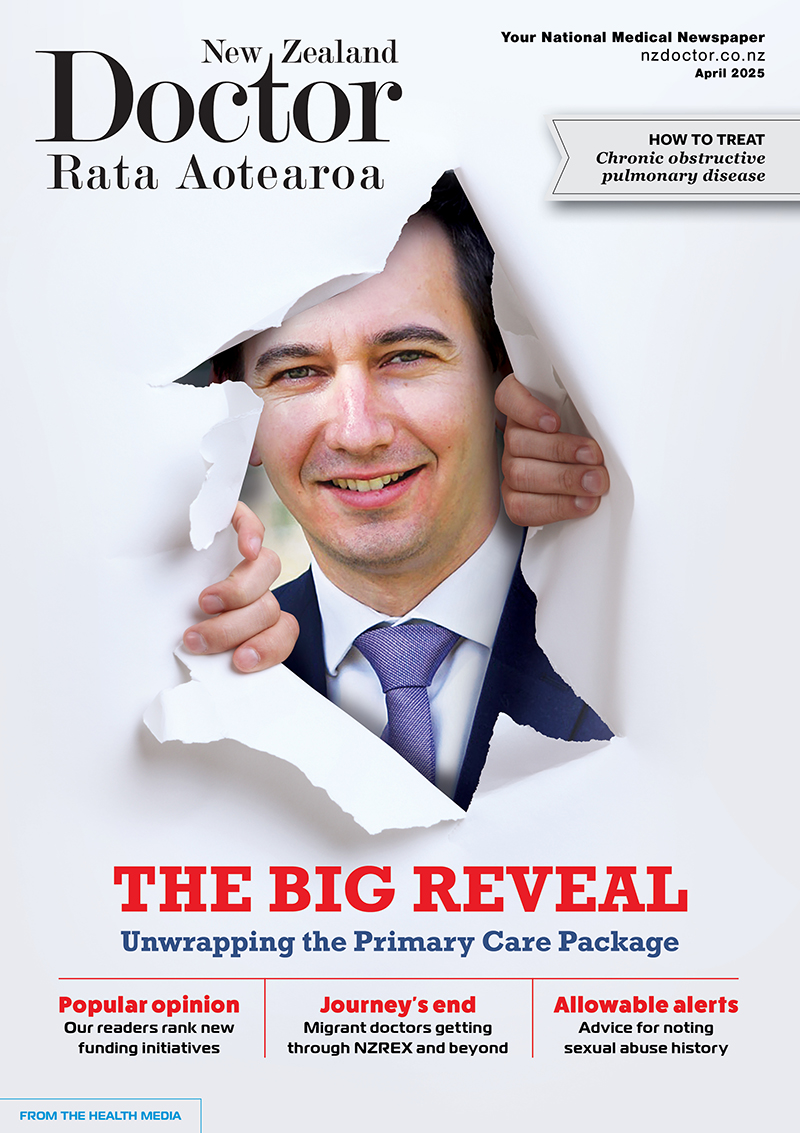Respiratory physician Lutz Beckert considers chronic obstructive pulmonary disease management, including the prevention of COPD, the importance of smoking cessation and pulmonary rehabilitation, and the lifesaving potential of addressing treatable traits. He also discusses the logic of inhaler therapy, moving from single therapy to dual and triple therapy when indicated, as well as other aspects of management
Still 1000 short: Pacific doctor forecast misses parity mark
Still 1000 short: Pacific doctor forecast misses parity mark

Essentials
-
The Ministry of Health forecasts a 43.7 per cent increase in Pacific doctors by 2034.
-
A public health academic claims that it falls over 1000 doctors short of what is needed to reflect the Pacific population in New Zealand.
-
The predicted growth comes off a very low base - only 522 Pacific doctors were recorded in 2024, making up just 2.6 per cent of the medical workforce.
A Ministry of Health forecast of a 43.7 per cent increase in the number of Pacific doctors by 2034 is ambitious and relies on the retention of supportive enrolment schemes, says public health academic Sir Collin Tukuitonga.
While the increase is “ambitious”, the associate dean (Pacific) at the University of Auckland says it comes off a “very low bar”.
The data used in the report was collected in 2024, and at that time, only 522 Pacific doctors were working in Aotearoa New Zealand, equating to 2.6 per cent of all doctors. This group included 92 specialist GPs, but data from 2023 showed the largest cohort (297) were non-specialists defined as trainees or medical officers.
Even with the predicted 43.7 per cent increase, Sir Collin says, the boost in clinicians still falls more than 1000 doctors short of the 1774 he estimates are needed to match the size of New Zealand’s mostly Samoan Pacific population.
The growth prediction is included in the initial volumes of the ministry’s five-part Tupu Ola Moui: Pacific Health Chart Book series, which breaks down overall population demographics and the Pacific healthcare workforce.
The three remaining volumes – on “healthier environments” and a two-part look at the wider health system – are due for release in July.
Tupu Ola Moui also predicts New Zealand’s Pacific population to increase from 442,632 (8.9 per cent of the total population) in 2023 to 664,600 (11.2 per cent) by 2043.
Enrolment programmes, such as Māori and Pacific Admission Scheme at the University of Auckland, are vital
While the report says the predicted growth in doctors is “well above” the 16.3 per cent anticipated across the entire medical workforce, the increased number is “still short of population parity”.
But it says: “The positive growth rate marks important progress toward an ethnically representative and culturally responsive workforce.”
The reports come as Health New Zealand Te Whatu Ora confirms the loss of 48.8 full-time-equivalent positions within its Pacific Health Unit, taking its complement from 148.2 to 99.4 FTE. Another 10.3 FTE vacant positions will also not be filled.
Sir Collin provided his take on Pacific healthcare challenges at the Global Pacific Solutions 2025 conference on 1 April.
These included the “hostile” approach of the Coalition Government to Māori and Pacific peoples; the dismantling or reversal of evidence-based policies recognising high needs within ethnic communities; the importation of “culture war” politics; the difficult financial environment; the lack of Pacific voices in Cabinet; and the inequitable make-up of the healthcare workforce.
Enrolment programmes, such as the Māori and Pacific Admission Scheme at the University of Auckland, are vital to support the recruitment and retention of Pacific candidates for medical training, Sir Collin says.
Such schemes are set to be reviewed by the Coalition Government.
As a counter, Sir Collin says public health, as a sector, should push back against political interference, and make the case for equity programmes based on evidence, social justice, Pacific values and the realities of demographic change and political cycles.








![Barbara Fountain, editor of New Zealand Doctor Rata Aotearoa, and Paul Hutchison, GP and senior medical clinician at Tāmaki Health [Image: Simon Maude]](/sites/default/files/styles/thumbnail_cropped_100/public/2025-03/Barbara%20Fountain%2C%20editor%20of%20New%20Zealand%20Doctor%20Rata%20Aotearoa%2C%20and%20Paul%20Hutchison%2C%20GP%20and%20senior%20medical%20clinician%20at%20T%C4%81maki%20Health%20CR%20Simon%20Maude.jpg?itok=-HbQ1EYA)
![Lori Peters, NP and advanced health improvement practitioner at Mahitahi Hauora, and Jasper Nacilla, NP at The Terrace Medical Centre in Wellington [Image: Simon Maude]](/sites/default/files/styles/thumbnail_cropped_100/public/2025-03/2.%20Lori%20Peters%2C%20NP%20and%20advanced%20HIP%20at%20Mahitahi%20Hauora%2C%20and%20Jasper%20Nacilla%2C%20NP%20at%20The%20Terrace%20Medical%20Centre%20in%20Wellington%20CR%20Simon%20Maude.jpg?itok=sUfbsSF1)
![Ministry of Social Development health and disability coordinator Liz Williams, regional health advisors Mary Mojel and Larah Takarangi, and health and disability coordinators Rebecca Staunton and Myint Than Htut [Image: Simon Maude]](/sites/default/files/styles/thumbnail_cropped_100/public/2025-03/3.%20Ministry%20of%20Social%20Development%27s%20Liz%20Williams%2C%20Mary%20Mojel%2C%20Larah%20Takarangi%2C%20Rebecca%20Staunton%20and%20Myint%20Than%20Htut%20CR%20Simon%20Maude.jpg?itok=9ceOujzC)
![Locum GP Helen Fisher, with Te Kuiti Medical Centre NP Bridget Woodney [Image: Simon Maude]](/sites/default/files/styles/thumbnail_cropped_100/public/2025-03/4.%20Locum%20GP%20Helen%20Fisher%2C%20with%20Te%20Kuiti%20Medical%20Centre%20NP%20Bridget%20Woodney%20CR%20Simon%20Maude.jpg?itok=TJeODetm)
![Ruby Faulkner, GPEP2, with David Small, GPEP3 from The Doctors Greenmeadows in Napier [Image: Simon Maude]](/sites/default/files/styles/thumbnail_cropped_100/public/2025-03/5.%20Ruby%20Faulkner%2C%20GPEP2%2C%20with%20David%20Small%2C%20GPEP3%20from%20The%20Doctors%20Greenmeadows%20in%20Napier%20CR%20Simon%20Maude.jpg?itok=B0u4wsIs)
![Rochelle Langton and Libby Thomas, marketing advisors at the Medical Protection Society [Image: Simon Maude]](/sites/default/files/styles/thumbnail_cropped_100/public/2025-03/6.%20Rochelle%20Langton%20and%20Libby%20Thomas%2C%20marketing%20advisors%20at%20the%20Medical%20Protection%20Society%20CR%20Simon%20Maude.jpg?itok=r52_Cf74)
![Specialist GP Lucy Gibberd, medical advisor at MPS, and Zara Bolam, urgent-care specialist at The Nest Health Centre in Inglewood [Image: Simon Maude]](/sites/default/files/styles/thumbnail_cropped_100/public/2025-03/7.%20Specialist%20GP%20Lucy%20Gibberd%2C%20medical%20advisor%20at%20MPS%2C%20and%20Zara%20Bolam%2C%20urgent-care%20specialist%20at%20The%20Nest%20Health%20Centre%20in%20Inglewood%20CR%20Simon%20Maude.jpg?itok=z8eVoBU3)
![Olivia Blackmore and Trudee Sharp, NPs at Gore Health Centre, and Gaylene Hastie, NP at Queenstown Medical Centre [Image: Simon Maude]](/sites/default/files/styles/thumbnail_cropped_100/public/2025-03/8.%20Olivia%20Blackmore%20and%20Trudee%20Sharp%2C%20NPs%20at%20Gore%20Health%20Centre%2C%20and%20Gaylene%20Hastie%2C%20NP%20at%20Queenstown%20Medical%20Centre%20CR%20Simon%20Maude.jpg?itok=Z6u9d0XH)
![Mary Toloa, specialist GP at Porirua and Union Community Health Service in Wellington, Mara Coler, clinical pharmacist at Tū Ora Compass Health, and Bhavna Mistry, specialist GP at Porirua and Union Community Health Service [Image: Simon Maude]](/sites/default/files/styles/thumbnail_cropped_100/public/2025-03/9.%20Mary%20Toloa%2C%20Porirua%20and%20Union%20Community%20Health%20Service%20in%20Wellington%2C%20Mara%20Coler%2C%20T%C5%AB%20Ora%20Compass%20Health%2C%20and%20Bhavna%20Mistry%2C%20PUCHS%20CR%20Simon%20Maude.jpg?itok=kpChr0cc)